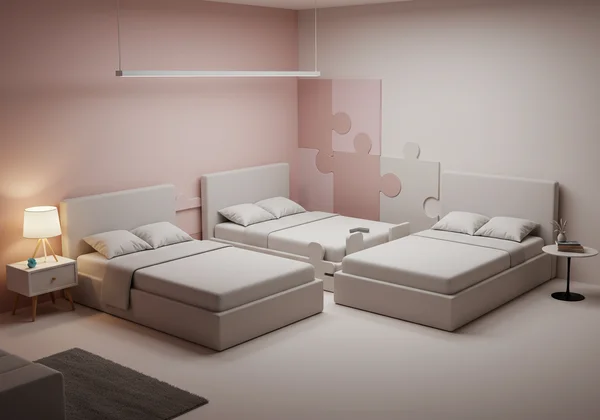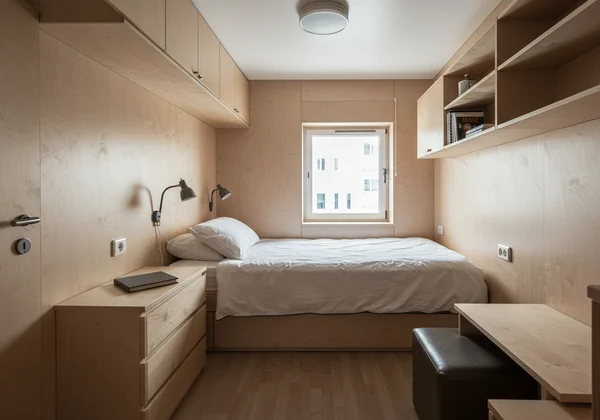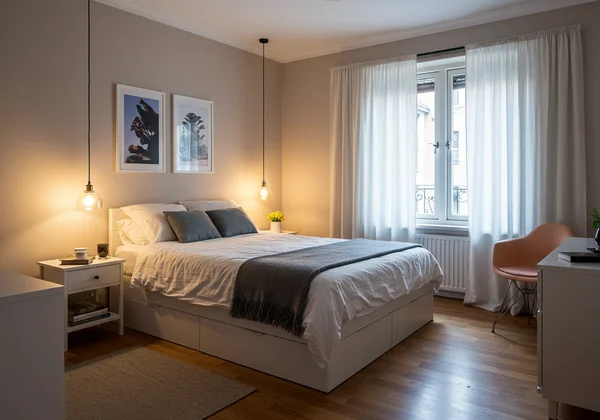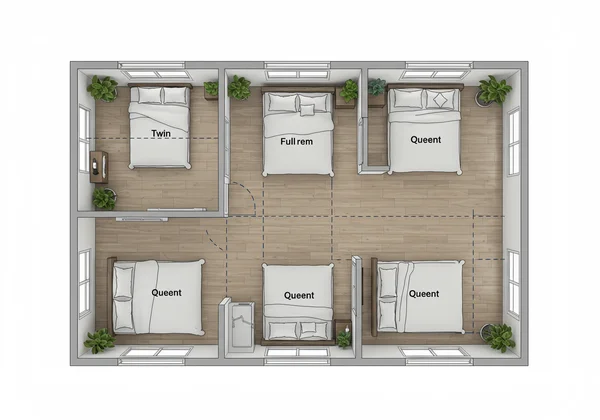Twin, Full, Queen: Best Bed Sizes for Small Rooms
Choosing the perfect bed for a small bedroom can feel like a puzzle. With limited square footage, every inch counts, turning the decision into a careful balancing act between comfort and functionality. You want a cozy retreat, not a cramped space dominated by a mattress. This guide will help you navigate the dimensions, pros, and cons of Twin, Full, and Queen beds to find the ideal fit. So, what size bed should I get for my limited space?
Finding the best bed sizes for small rooms goes beyond just measurements; it involves considering your lifestyle, sleeping habits, and how you use your room. While this guide offers a solid foundation, the truly perfect choice is personal. For a data-driven answer tailored to you, get your recommendation on our homepage.

Understanding Twin Bed Dimensions for Small Spaces
When space is at an absolute premium, the Twin bed is often the go-to solution. It's the smallest standard mattress size available for adults, making it an excellent choice for children's rooms, dorms, or a twin bed in guest room setups where maximizing floor space is the top priority.
Exact Twin Bed Measurements: Inches & Centimeters
A standard Twin mattress measures 38 inches wide by 75 inches long (approximately 97 cm x 191 cm). This compact footprint leaves ample room for other essential furniture like a desk or a dresser, even in a very small room. For interior designers and planners, these precise dimensions are crucial for creating functional layouts.
Who is a Twin Bed Best For in Limited Room Sizes?
A Twin bed is the ideal choice for a single sleeper. It suits children transitioning from a crib, teenagers, and single adults with a smaller stature. For first-time apartment dwellers or students, a Twin offers a comfortable sleeping area without consuming the entire room, aligning with many small bedroom bed ideas.
Pros & Cons of a Twin Bed for Maximizing Space
Pros:
- Maximum Space Savings: Its narrow profile frees up significant floor space for walking and other furniture.
- Affordability: Twin mattresses and bedding are typically the most budget-friendly options.
- Versatility: Two Twin beds can be used in a shared children's room or guest room, offering flexible arrangements.
Cons:
-
Limited for Single Adults: Active sleepers or taller individuals may find a Twin bed restrictive. Anyone over 6 feet tall might find their feet dangling off the end.
-
Not for Couples: It is strictly a one-person bed and unsuitable for couples.

Full Size Beds: A Smart Option for Compact Bedrooms?
A Full bed, also known as a double bed, represents a significant step up in width from a Twin. It's often considered the best bed for small room scenarios where a single sleeper wants more personal space to stretch out, or for couples who don't mind cozying up.
Full Bed Dimensions: Space vs. Comfort Trade-offs
A Full mattress measures 54 inches wide by 75 inches long (137 cm x 191 cm). Those extra 16 inches of width compared to a Twin make a world of difference for a solo sleeper. However, it shares the same length as a Twin, which can still be a drawback for taller individuals. The main trade-off is sacrificing some floor space for that extra sleeping comfort.
Can a Full Bed Comfortably Accommodate Two in a Small Room?
This is a common question. While a Full bed can technically fit two adults, it provides each person with only 27 inches of space—the same width as a crib. It can work for shorter periods or for couples who prefer very close quarters, but for long-term comfort, most find it too narrow.
Advantages & Disadvantages of a Full Size Bed for Small Rooms
Pros:
- Luxurious for One: An excellent choice for a single adult who wants to spread out without upgrading to a Queen.
- Fits in Most Bedrooms: It can comfortably fit into smaller rooms (e.g., 9 ft x 10 ft) while still leaving some space for nightstands.
- More Affordable than a Queen: Bedding and frames for Full sizes are generally less expensive than for Queen sizes.
Cons:
- Tight for Couples: Offers very limited personal space for two sleepers.
- Same Length as a Twin: Not ideal for sleepers over 6 feet tall.
Deciding between a Full and a Queen often comes down to inches. To see how these dimensions fit your unique profile, find your perfect fit with our intelligent tool.

Queen Size Beds in Small Spaces: Is It Worth the Squeeze?
The Queen bed is the most popular mattress size in the United States, and for good reason. It offers a comfortable amount of space for both couples and single sleepers. The challenge, however, is determining if it's a wise choice for a small bedroom. Your priorities and room dimensions will dictate the answer.
Queen Bed Dimensions & Minimum Room Requirements
A standard Queen mattress measures 60 inches wide by 80 inches long (152 cm x 203 cm). This makes it 6 inches wider and 5 inches longer than a Full bed. While those few inches may not sound like much, they provide significantly more comfort, especially for couples or taller individuals. As a general rule, a minimum room size of 10 feet by 10 feet is recommended for a Queen bed to allow for walking space.
When a Queen Bed Makes Sense for a Small Bedroom
A Queen bed is the right choice if the bedroom is your primary sanctuary and sleep comfort is your top priority. If you are a couple, or a single sleeper who values ample space, fitting a Queen might be worth sacrificing some floor area. This is a key decision in the full vs queen for small room debate.
The Compromises of Fitting a Queen into a Small Room
Placing a Queen bed in a room smaller than 10x10 feet is possible, but it requires compromises. You may have to opt for smaller nightstands, a narrower dresser, or forgo extra furniture entirely. It's crucial to ensure you still have at least 24-30 inches of clearance on the sides and foot of the bed for comfortable movement. Still unsure? Let our algorithm do the work and provide a personalized suggestion.
Comparing Twin, Full, and Queen for Optimal Small Room Layouts
Seeing the numbers is one thing, but visualizing the beds in your space is another. The right choice depends on a combination of dimensions, room layout, and personal lifestyle. Let’s break it down to make your decision easier.
Visual Size Comparison Chart: Twin vs Full vs Queen
| Feature | Twin | Full | Queen |
|---|---|---|---|
| Dimensions (in) | 38" x 75" | 54" x 75" | 60" x 80" |
| Dimensions (cm) | 97 x 191 cm | 137 x 191 cm | 152 x 203 cm |
| Best For | Single Sleeper | Solo Sleeper / Cozy Couple | Couples / Tall Individuals |
| Min. Room Size | 7' x 10' | 9' x 10' | 10' x 10' |
This bed sizes chart is a great starting point, but our recommendation tool considers more factors.

Considering Other Furniture & Walkway Clearance
Before you buy, measure your room and map out your furniture. A bed doesn't exist in a vacuum. You need to account for door swings, closet access, and space for dressers or a desk. A key principle of good room layout is to maintain at least 24 inches (and ideally 30 inches) of walkway clearance around the bed to avoid feeling boxed in.
Matching Bed Size to Your Lifestyle in Limited Space
Ultimately, your lifestyle should dictate your choice. Are you a single student who needs a study area? A Twin is likely best. Are you a young professional who loves to sprawl out while sleeping alone? A Full offers a great balance. Are you a couple prioritizing sleep comfort above all else? A Queen is worth the squeeze. The answer is unique to your situation.
Finding Your Perfect Fit for Small Bedroom Living
Choosing between a Twin, Full, or Queen for a small room is a decision filled with trade-offs. A Twin maximizes your living area, a Full offers a luxurious upgrade for one, and a Queen provides the best comfort for two if you can spare the space. By considering the exact dimensions, your lifestyle, and your room's layout, you can make an informed choice.
However, why guess when you can know for sure? The information here is a great general guide, but your height, weight, sleeping position, and even partner movement sensitivity all play a role. Instead of getting lost in the details, use our intelligent mattress size recommendation tool on the homepage. In just a few clicks, receive a personalized recommendation that eliminates guesswork and empowers you to find your perfect mattress size with confidence. Try our free tool today!
Frequently Asked Questions About Small Bedroom Bed Sizes
Is a full bed big enough for two people in a small room?
A Full bed is very tight for two adults, offering each person only 27 inches of width. While it can work for occasional use or for couples who prefer close contact, most find it too small for comfortable, long-term sleep. The decision often comes down to a trade-off between sleeping space and floor space in the room.
What are the minimum room dimensions required for a Queen bed?
For a Queen bed, a room that is at least 10 feet by 10 feet is recommended. This allows for the bed itself and provides approximately 30 inches of clearance on three sides for walking and placing small nightstands. Anything smaller will feel very cramped.
How do I accurately measure my bedroom to ensure a bed fits?
Use a tape measure to find the length and width of your room. Sketch a simple floor plan and mark the locations of doors, windows, and closets. Remember to account for door swings. This will help you visualize not just if the bed fits, but how much usable space you'll have left. You can find a comprehensive mattress size guide on our site.
What size bed should I get if I have a very small room and sleep alone?
For a very small room (e.g., 7 ft x 10 ft), a Twin bed is almost always the best option. It provides a comfortable sleeping space for a single person while maximizing the available floor area for movement and other furniture.
Is a Twin XL a good option for a small guest room, and how does it compare to a Twin?
A Twin XL is an excellent choice for a guest room, especially if you anticipate taller guests. It has the same width as a standard Twin (38 inches) but is 5 inches longer (80 inches total), the same length as a Queen. It's a fantastic space-saving solution for accommodating taller single sleepers without taking up extra width.